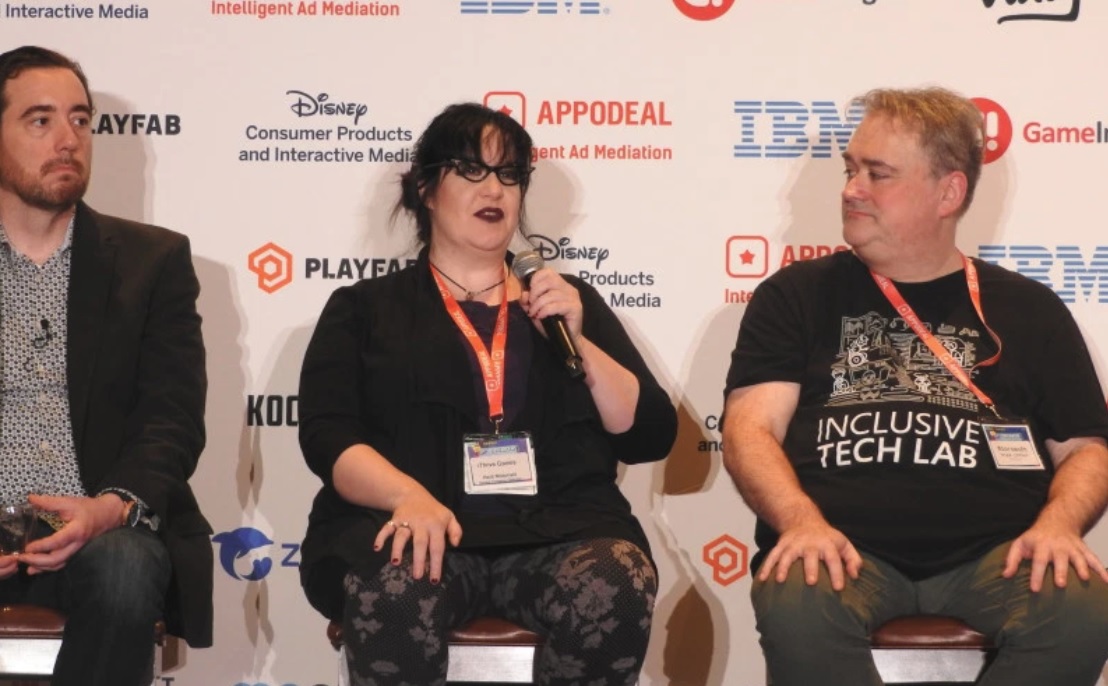
Above: Heidi McDonald is senior creative director at iThrive Games.
Figueroa: Coming full circle on this, arcade games knew how to do this, to get you to put that coin back in and hop back in the game. Dying could be frustrating but fun. These monetization and retention strategies are strategies that we had for a long time, but we’ve forgotten them.
McDonald: One thing we’re working on at iThrive right now is the question of whether it’s possible to design an empathy game on purpose. I’m asking that because Oxenfree was something I thought was one of the best empathy games of last year, and I expect to have some very interesting conversations with these folks about whether they set out to do that or it happened by accident. Lucas Pope, who made Papers, Please — I don’t think he sat down and said, “I’m going to make a good empathy game,” but that doesn’t mean he didn’t do it.
What we have to figure out right now is, the people who did make a good game, did they do it on purpose? And if so, what did they use? Is that something we can take and apply to other designs, or can we come up with a design independently of games that have already been made? That would also extend to other types of ability, I think.
Johnson: In Gaming for Everyone we talk about intentionality a lot. We have a saying that if you don’t intentionally include, you’re going to unintentionally exclude, and if you intentionally exclude, you’re going to be kind of a jerk. But that intentionality is really important. There are lots of happy accidents that we can learn from, but it’s important that when those accidents happen, we document them and understand what made them great. The next time, we can do that intentionally.
Barlet: Accidental accessibility — saying, “Oh, this is good, let’s make sure we bring that forward.” Forza is an example. Forza actually won our competition one year, but then, the next iteration was actually more inaccessible than the one from the year prior. The one that had the Top Gear people on it actually took a regression in accessibility before the next one corrected those issues.
Johnson: We do that a lot at Microsoft [laughter]. We go forward and then back. But I totally see how it happens. If you talk to the team — Aaron, one of the physics designers, we talk about accessibility a lot. He talks about how, “Oh, I made this mode for my kids.”
Barlet: Microsoft does a really good job on closed captioning. The use case we’re talking about was called the Sleeping Baby use case. Microsoft did a studio where they found that a lot of the people who played their games were males aged 28 [to] 35 who were sneaking downstairs to play after the baby went to sleep. They assumed that a lot of them would have the volume low or turned off because if you woke up the baby, your wife was going to destroy you. So, they were designing games with this one use case as part of their thinking. Can you consume this game with no sound? And that was also great for the deaf gamer, but they weren’t setting out to make the game accessible to the deaf. They were making it accessible to a 32-year-old guy with a newborn baby and a wife.
Johnson: I don’t know if you’ve seen this on the Xbox One, but do you remember the snap mode? I’ll tell you where that came from. We saw a post on Reddit where some guy was playing Titanfall, and he’d snap the baby monitor on the side of his screen, so he could play and watch the baby at the same time. That’s where a lot of that inspiration comes from.

Above: Forza Motorsport 7 has more than 700 cars.
Figueroa: One of my friends is creating a kid mode in their game, where it’s local co-op, but the kid is more just running around and having fun. But they’re still experiencing the game. Forza has a similar thing where you can turn it on, so you don’t have collisions. You still have to drive, but it turns a hard game into a casual game.
McDonald: It’s interesting to think about what cases of emergent play are going on in games. I have a 13-year-old son. We bought [Assassin’s Creed Origins], but we have never played through the story or otherwise played the game the way it’s intended. The first time we logged in, my son decided it was way more fun to stampede camels through markets and commandeer boats to drive them through flocks of birds. That’s all we’ve ever done.
Barlet: My 45-year-old husband did the same thing [laughter]. “Are you advancing the story?” “Why should I? Watch this!”
McDonald: Finding out the ways of playing a game that are unconventional, that you don’t know about, and how that can inform your designs going forward.
Johnson: One of the ways I try to sell blind gaming within Xbox is driving and playing games. Basically taking the situational impairment of an eyes-free situation, driving, and then figuring out how to apply that to games.
Barlet: I’m stealing that.
Johnson: You totally should. I would seriously love that, if in a few years we had driving games where….
McDonald: We might be already there? My friend Ed Webb, who made Pugmire — he’s written for a lot of different franchises like Futurama, Vampire, stuff like that. He co-invented a company called Earplay. They’re trying to make games to go with the Alexa system, where it’s totally auditory. It’s a story game, a choose-your-own-adventure, but it’s all audio.
Figueroa: Which, again, is a classic game mechanic. These text-based, choice-based games are something we really loved.
Cannon: We could port Oxenfree to that. Of course, we might not have to worry about that because in self-driving cars, you might just be able to play your game. Except for me. I’d just be in terror looking for a steering wheel.
Going back to what you were saying about empathy, it’s an interesting thought because to me, that’s why we tell stories. It goes hand in hand for games with characters and stories, and that’s what we’re trying to do. I’m really excited for the day when — well, we kind of are in a time where games can join books and films as — where difficulty is the emotional journey you take.
Johnson: Do we see an Oscar for games at some point?
Cannon: I talk to friends about this a lot. The hard thing about games is that we don’t have the equivalent of movie stars — or a part of the development team that’s forward facing to the audience. Designers and programmers and artists in video games aren’t forward-facing people.
McDonald: Devs are famous to other devs. If I see David Gaider, who made Dragon Age, I’ll turn into a stuttering girl. But if you say any of those names to people outside of games, they’ll say, “Who?”
Figueroa: We’re getting a little off-topic now, so I’ll say this and then divert us back. There’s a blending of — maybe we can learn something about good design as the movie industry picks up more and more of our tools like Unreal and Unity. That line is blurring quickly, and it turns out that they have way better established work flows than we do. I feel like there’s borrowing that can happen both ways in terms of accessibility and good design.

Above: Senua from Hellblade: Senua’s Sacrifice is an ordinary character, except for the blue tattoo.
Audience: What do you guys think of a game like Hellblade? To me, it was interesting because it made the topic of mental illness accessible to people who wouldn’t otherwise understand it because of the way it was built into gameplay. But a lot of people who are interested in the subject possibly couldn’t play that game because it required so much core gaming skill.
McDonald: My team and I are looking at that right now as far as whether there’s any education we can do around that game. Are there any studies that can be done around it to show that it helps people? I know that there have been mixed reactions. Some people think it’s too intense.
Cannon: I played Hellblade a few weeks ago and followed some of the controversy around it. To me, it’s very much a game for gamers that builds empathy for people with mental illness. It sounds like a lot of people who are upset that someone who has psychosis wouldn’t be able to play the game because it wasn’t designed for them, which is — perhaps it should be? But I still think the game had a lot of value in just the fact that — a gamer, someone who plays a lot of games, can understand a tiny bit more what people with that kind of mental illness go through.
McDonald: It was smart of them to use the number of subject matter experts they did, definitely.
Audience: I’m making a game where we’re actively trying to teach empathy, so I’m curious about — we talk about things like mental health, disabilities, blindness, dyslexia, depression. In terms of marketing our game, we feel like it can reach a lot of people, but if we trade on the fact that it’s also about mental-health awareness, we’re wondering if that can deter people. We feel like, in trying to teach people about empathy, we want people who don’t necessarily know what depression is like to play the game, so they can learn more about it and maybe know how to talk to someone else in real life.
Johnson: I personally, in the work we do — we don’t really use the term “empathy building” in a lot of ways. There’s a quotation, and I can never remember who said it, but it goes, “True empathy is knowing that you’re not the other person.” This idea of walking in someone else’s shoes is kind of a misconception. We emphasize that we want to bring people in and hear from them.
There’s also a Harvard Business Review studio that shows that when managers try to empathize, they tend to take the feelings that a person has and internalize it around their own opinions. They end up thinking that the solutions they want are also going to help this other person. Empathy is tricky that way. I’m not trying to be discouraging, but I think it’s very good that you’re cautious about this.
Cannon: I would make a great game and then not tell anybody that it’s an empathy game.

